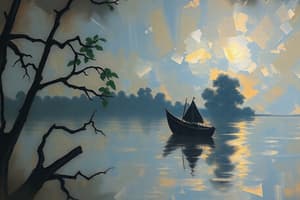Podcast
Questions and Answers
What is the importance of proportion in art?
What is the importance of proportion in art?
- To create an asymmetrical balance
- To create a sense of realism by scaling objects correctly (correct)
- To create a sense of movement in an artwork
- To ensure that objects in the foreground are smaller than those in the background
What is asymmetric balance?
What is asymmetric balance?
- The use of radial balance in an artwork
- The absence of symmetry in an artwork (correct)
- A mirror image on both sides of an artwork
- The arrangement of elements to create a sense of movement
What is the primary purpose of emphasis in an artwork?
What is the primary purpose of emphasis in an artwork?
- To create a sense of balance in the composition
- To draw attention to a specific area of the artwork (correct)
- To create a sense of harmony in the color palette
- To create a sense of movement in the artwork
What type of balance is achieved by stretching all elements from a central point?
What type of balance is achieved by stretching all elements from a central point?
Which of the following is an example of emphasis using contrast?
Which of the following is an example of emphasis using contrast?
What is a focal point in an artwork?
What is a focal point in an artwork?
What is the result of arranging elements symmetrically or asymmetrically in an artwork?
What is the result of arranging elements symmetrically or asymmetrically in an artwork?
How can emphasis be achieved in an artwork?
How can emphasis be achieved in an artwork?
Why is proportion important when depicting the human face and body in art?
Why is proportion important when depicting the human face and body in art?
What is the purpose of contrast in an artwork?
What is the purpose of contrast in an artwork?
What is the primary purpose of using contrast in an artwork?
What is the primary purpose of using contrast in an artwork?
What type of rhythm is created when elements are repeated without specific regular intervals?
What type of rhythm is created when elements are repeated without specific regular intervals?
What is the definition of pattern in art?
What is the definition of pattern in art?
What is harmony and unity in art?
What is harmony and unity in art?
What does proportion refer to in art?
What does proportion refer to in art?
Flashcards are hidden until you start studying
Study Notes
Emphasis and Contrast
- Emphasis refers to an area of dominance in an eye-catching work of art, creating a focal point.
- Emphasis can be achieved by placement, contrast, color, size, and repetition.
- Examples of emphasis include:
- Emphasis using size, where a larger element draws attention.
- Emphasis using color, where a bold or contrasting color stands out.
- Emphasis using form, where a unique shape or texture draws attention.
Contrast
- Contrast is a big difference between two things, creating visual interest.
- Contrast is used to create a difference between a focal point and the rest of the artwork.
- Examples of contrast include:
- Differences in color, shape, texture, and more.
- Placing a light color next to a dark color to create contrast.
Focal Point
- A focal point is the place in a work of art where the eye goes first, grabbing attention.
- The focal point helps to understand the main concept of the artwork.
- Emphasis can be used to create a focal point by creating contrast between the focal point and the rest of the artwork.
Rhythm/Movement and Pattern
Rhythm/Movement
- Rhythm/movement is created by the regular repetition of elements to direct the eye through the artwork.
- Types of rhythm include:
- Random rhythm, where elements are repeated without specific intervals.
- Regular rhythm, where elements are repeated at regular intervals.
- Progressive rhythm, where a characteristic of a motif is changed while repeating it.
- Flowing rhythm, where elements are repeated in arcs, curves, and waves.
Pattern
- A pattern is the repetition of lines, shapes, textures, colors, and other elements to decorate or enhance artworks.
- Patterns can be created using different elements, such as:
- Repeating lines, shapes, and colors.
Harmony/Unity, Proportion/Scale, Balance
Harmony/Unity
- Harmony/unity is created when elements are arranged to make the artwork look complete.
- Harmony makes the viewer feel that parts in the image are balanced and form a whole image.
- Examples of harmony and unity include:
- Using form, color, and repetition to create a harmonious image.
Proportion/Scale
- Proportion refers to the size of parts of an object in comparison to each other.
- Scale refers to the size or position of one object in relation to another.
- Proportion is important in art, especially when it comes to the human face and body.
- Examples of proportion and scale include:
- Using size to create relationships between objects in a picture.
- Considering the foreground, middle ground, and background in a picture.
Balance
- Balance is created when the elements of design are arranged symmetrically or asymmetrically to create equality in weight or importance.
- Types of balance include:
- Symmetrical balance, where both sides are the same.
- Asymmetrical balance, where both sides have unequal visual weight but are still balanced.
- Radial balance, where elements are stretched from a central point.
Studying That Suits You
Use AI to generate personalized quizzes and flashcards to suit your learning preferences.




